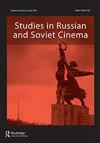Armenian cinema in the late Soviet years: desexualisation as a narrative convention
IF 0.4
0 FILM, RADIO, TELEVISION
引用次数: 0
Abstract
ABSTRACT This article addresses Soviet-Armenian love narratives in cinema in the Soviet political and cultural context, revealing the negative impact of ideological restrictions on Armenian romance films between 1970 and 1990. On the one hand, the state censorship of film production and, on the other hand, the local conventions on social and sexual mores were detrimental to the development of Armenian romance films through a sanitisation of the subject-matter, particularly sexuality. The article examines Armenian love narratives through the philosophy of the being of love and with reference to the principles of realistic narratives and the romance genre. In a range of aspects, from cinematic articulation of heterosexual love, through a variety of theories of cinematic realism to features of visual narration, Armenian love narratives are shown to make use of a set of features aimed at the desexualisation of male and female love interests. Using a selection of films from the 1970s and 1980s with desexualised love narratives, the argument is made that characterisation and narrative are deficient inasmuch as they refrain from realistic representations of Armenian men and women in psycho-sexual terms.苏联后期的亚美尼亚电影:作为叙事惯例的去性别化
本文在苏联政治和文化背景下探讨了苏联-亚美尼亚电影中的爱情叙事,揭示了1970年至1990年间意识形态限制对亚美尼亚爱情电影的负面影响。一方面,国家对电影制作的审查,另一方面,当地关于社会和性习俗的习俗,通过对题材,特别是性的净化,对亚美尼亚爱情电影的发展是有害的。本文考察了亚美尼亚的爱情叙事通过哲学的爱的存在和参考原则的现实主义叙事和浪漫类型。在一系列方面,从异性恋的电影表达,通过各种电影现实主义理论到视觉叙事的特点,亚美尼亚的爱情叙事被证明利用了一系列旨在使男女爱情利益去性化的特征。本文选取了20世纪70年代和80年代的一些非性别化的爱情叙事电影,认为刻画和叙事存在缺陷,因为它们避免了从性心理角度对亚美尼亚男人和女人的现实表现。
本文章由计算机程序翻译,如有差异,请以英文原文为准。
求助全文
约1分钟内获得全文
求助全文

 求助内容:
求助内容: 应助结果提醒方式:
应助结果提醒方式:


